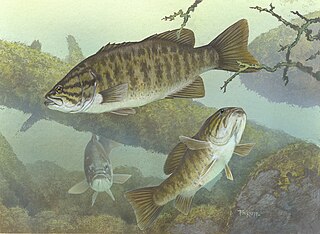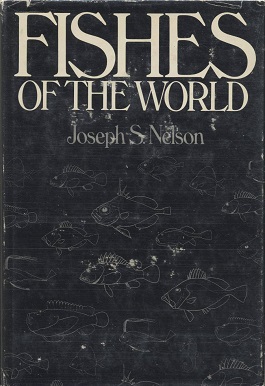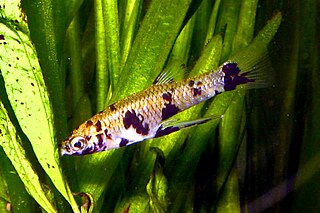
The Poeciliidae are a family of freshwater fishes of the order Cyprinodontiformes, the tooth-carps, and include well-known live-bearing aquarium fish, such as the guppy, molly, platy, and swordtail. The original distribution of the family was the Southeastern United States to north of Río de la Plata, Argentina, and Africa, including Madagascar. Due to release of aquarium specimens and the widespread use of species of the genera Poecilia and Gambusia for mosquito control, though, poeciliids can today be found in all tropical and subtropical areas of the world. In addition, Poecilia and Gambusia specimens have been identified in hot springs pools as far north as Banff, Alberta.

Micropterus is a genus of freshwater fish in the sunfish family (Centrarchidae) of order Perciformes. The species of this genus are known as the black bass.

Characidae, the characids or characins is a family of freshwater subtropical and tropical fish, belonging to the order Characiformes. The name "characins" is the historical one, but scientists today tend to prefer "characids" to reflect their status as a by and large monophyletic group at family rank. To arrive there, this family has undergone much systematic and taxonomic change. Among those fishes that remain in the Characidae for the time being are the tetras, comprising the very similar genera Hemigrammus and Hyphessobrycon, as well as a few related forms such as the cave and neon tetras. Fish of this family are important as food and also include popular aquarium fish species.

Fishes of the World by Joseph S. Nelson is a standard reference for fish systematics. Now in its fifth edition (2016), the work is a comprehensive overview of the diversity and classification of the 30,000-plus fish species known to science.

Grenadiers or rattails are generally large, brown to black gadiform marine fish of the subfamily Macrourinae, the largest subfamily of the family Macrouridae. Found at great depths from the Arctic to Antarctic, members of this subfamily are amongst the most abundant of the deep-sea fish.

Labrisomids are small blennioids (blennies), percomorph marine fish belonging to the family Labrisomidae. Found mostly in the tropical Atlantic and Pacific Ocean, the family contains about 110 species in 15 genera.

Clinidae is a family of marine fish in the order Blenniiformes within the series Ovalentaria, part of the Percomorpha. Temperate blennies, the family ranges from the Atlantic, Pacific, and Indian Oceans, in both the Southern and Northern Hemispheres. The family contains about 86 species in 20 genera, the 60-cm-long giant kelpfish being the largest; most are far smaller.

The Lamnidae are the family of mackerel or white sharks. They are large, fast-swimming sharks, found in oceans worldwide. The name of the family is formed from the Greek word, lamna, which means fish of prey, and was derived from the Greek legendary creature, the Lamia.

Etheostoma is a genus of small freshwater fish in the family Percidae native to North America. Most are restricted to the United States, but species are also in Canada and Mexico. They are commonly known as darters, although the term "darter" is shared by several other genera. Many can produce alarm pheromones that serve to warn nearby fish in case of an attack.

Pupfish are a group of small killifish belonging to ten genera of the family Cyprinodontidae of ray-finned fish. Pupfish are especially noted for being found in extreme and isolated situations. They are primarily found in North America, South America, and the Caribbean region, but Aphanius species are from southwestern Asia, northern Africa, and southern Europe. As of August 2006, 120 nominal species and 9 subspecies were known. Several pupfish species are extinct and most extant species are listed. In the U.S., the most well-known pupfish species may be the Devil's Hole Desert Pupfish, native to Devil's Hole on the Nevada side of Death Valley National Park. Since 1995 the Devil's Hole Pupfish has been in a nearly steady decline, where it was close to extinction at 35–68 fish in 2013.
Bathygadus is a genus of rattails of the family Bathygadidae.

Lamna is a genus of mackerel sharks in the family Lamnidae, containing two extant species: the porbeagle of the North Atlantic and Southern Hemisphere, and the salmon shark of the North Pacific.

Carl Leavitt Hubbs was an American ichthyologist.

Goodeinae is a subfamily of splitfins from Mexico, part of the family Goodeidae. They are small fish which mostly live in fresh water, especially around Mesa Central, west of Mexico City. Members of the subfamily are also found in brackish water on both the east and west coasts. They typically have small ranges and many are seriously threatened. The subfamily takes its name from its type genus Goodea and so is ultimately named after the American ichthyologist George Brown Goode (1851-1896).

Poeciliinae is a subfamily of killifish from the family Poeciliidae which contains species from the Americas which are collectively known as the livebearers because many, but not all, of the species within the subfamily are ovoviviparous.
Clark Hubbs was an American ichthyologist who was professor of zoology at the University of Texas from 1963 until he accepted emeritus status in 1991. He was a leading figure in ichthyology in Texas, teaching many students who went on to be renowned in the field, was actively involved in many ichthyological societies and was an editor of scientific journals. Hubbs was also an environmental activist, fighting to conserve freshwater ecosystems.

Atherinopsinae is a subfamily of the Neotropical silversides, part of the family Atherinopsidae. This subfamily is made up of two tribes, six genera and around 30 species. They are found in the eastern Pacific and south-western Atlantic and the subfamily contains marine, brackish and freshwater species.

The Heterandriini is a tribe of killifishes from the "livebearer" family Poeciliidae, consisting of seven genera and around 50 species. The tribe was originally delineated by Carl Leavitt Hubbs in 1924.

The Girardini is a tribe of killifishes from the "livebearer" family Poeciliidae, consisting of three genera and 10 species. The tribe was originally delineated by Carl Leavitt Hubbs in 1924.

Cnesterodontini is a tribe of fishes which are within the subfamily Poeciliinae of the family Poeciliidae. This tribe is distinguished from other tribes in the Poeciliinae by the males having five rays in the pelvic fin, there is a pedicle at the base of the third ray which joins it to the fourth ray, another pedicle at the third rays tip and a membrane there too.


















